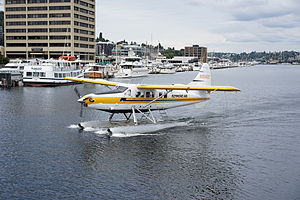UB-1 Otter
| DHC-3 Otter | |
|---|---|
 |
|
| Turbine Otter in Kenmore Air livery | |
| Role | STOL utility transport |
| Manufacturer | de Havilland Canada |
| First flight | 12 December 1951 |
| Introduction | 1953 |
| Status | Active |
| Produced | 1951–1967 |
| Number built | 466 |
| Developed from | DHC-2 Beaver |
| Developed into | DHC-6 Twin Otter |
The de Havilland Canada DHC-3 Otter is a single-engined, high-wing, propeller-driven, short take-off and landing (STOL) aircraft developed by de Havilland Canada. It was conceived to be capable of performing the same roles as the earlier and highly successful Beaver, but is overall a larger aircraft.
When de Havilland Canada began design work on the "King Beaver" (the Otter's original name) in January 1951, it was trying to extend the company's line of rugged STOL utility transports that had begun with the Beaver. The single-engined, high-wing, propeller-driven DHC-3 Otter was conceived to be capable of performing the same roles as the Beaver, but was considerably larger, the veritable "one-ton truck" (in company parlance, the Beaver was the "half-ton truck"). Using the same overall configuration as the earlier and highly successful DHC2 Beaver, the new design incorporates a longer fuselage, greater-span wings, a cruciform tail, and is much heavier. Seating in the main cabin is for 10 or 11, whereas the Beaver can seat six. Power is supplied by a 450-kW (600 hp) Pratt & Whitney R-1340 geared radial. The version used in the Otter was geared for lower propeller revolutions and consequently lower airspeed. The electrical system was 28 volts D.C. Like the Beaver, the Otter can be fitted with skis or floats. The Otter served as the basis for the very successful Twin Otter, which features two wing-mounted Pratt & Whitney Canada PT6 turboprops.
The Otter received Canadian certification in November 1952 and entered production shortly thereafter. A total of 466 were manufactured.
The DHC-3/CC-123/CSR-123 Otter was used until 1980 by the Royal Canadian Air Force and its successor, the Air Command of the Canadian Forces. It was used in Search and Rescue, as the "CSR" denotes Canadian Search (and) Rescue (type 123) and as a light utility transport, "CC" denoting Canadian Cargo. During the Suez Crisis, the Canadian government decided to provide assistance to the United Nations Emergency Force and the Royal Canadian Navy carrier HMCS Magnificent carried 4 Otters from Halifax to Port Said in Egypt early in 1957, with all four flying off unassisted while the ship was at anchor. This was the only occasion when RCAF fixed wing aircraft operated from a Canadian warship. It was also operated on EDO floats on water and skis for winter operations on snow. The EDO floats also had wheels for use on runways (amphibious). It was used as army support dropping supplies by parachute, and also non-parachute low-speed, low-altitude air drops, to support the Canadian Army on maneuvers. In the end it was operated by the Primary Air Reserve in Montreal, Toronto, Edmonton and Winnipeg, with approximately 10 aircraft at each base, as well as by the RSU (Regular (Forces) Support Units) at those bases. It was usually flown with a single pilot (Commissioned Officer) in the left seat and a Technical Air Crewman (NCO) in the right seat. The Kiowa helicopter replaced it in Air Reserve squadrons.
...
Wikipedia
